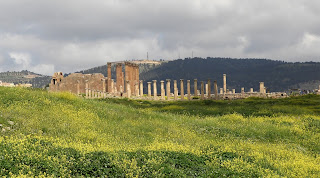 |
| Temple of Hercules at the Citadel, Amman |
Amman is the "white city" because buildings are required to be built or faced with limestone or alabaster. It is also built on thousands of years of history from the Iron Ages forward, through Ammonites to Nabataeans to Greeks, Romans, Byzantines, Ottomans and today's Jordanians.
 |
| view of Amman from the Citadel |
The best view of the city is from the Roman Citadel on top one of Amman's hills, with its 360 degree views of the city's hills and valleys. There is a wonderful small museum in the Citadel that has well-designed displays of pottery, statues, jewelry and other artifacts, starting with the earliest Iron Age 10,000 years ago.
 |
| Roman amphitheater, Amman |
Today was chilly, but beautiful, as the sun shone on the limestone temples of the Citadel, making them glow against the dark clouds.
About an hour north of Amman is the Greco-Roman city of Jerash which was mostly destroyed by an earthquake in the mid-8th century AD. These are the ruins that remain, but before this time, the area was occupied by Iron Age settlements. Alexander the Great reportedly founded the city on his way from Egypt to Mesopotamia in 331 BC.
There has been much excavation and restoration work in Jerash since the mid-1990's. Before that, it was mostly covered with sand. As you look out across the surrounding hills, you can see many piles of rubble, presumably Roman buildings destroyed in the 749 AD earthquake. There is much more work to do, but resources are spread thin across all the archaeological work that needs to be done around the world. Meanwhile, a visit to Jerash is wonderful right now.
 |
| Jerash--flowers and colonnade |
This is the city of a thousand columns--or something like that. They stand everywhere, along the long avenues that cut through the center of the ancient city, surrounding the Forum and many temples, framing the gates to the city.
 |
| Roman capital, Jerash |
Beautifully decorated capitals line the avenues and temples, ready to be reinstalled someday atop the columns they once graced.
You enter the city through the Gate of Hadrian, the same Hadrian who built the wall across northern England. This gate leads to a long boulevard lined by columns and on to the Forum, a large and graceful space with surrounding columns. There are many highlights, but one is certainly the Theater, a Roman amphitheater with stone seats rising from the stage below. Some of the world's leading singers have performed here during the summer concerts. It must be a fabulous evening to sit in this lovely space listening to arias.
 |
| Roman theater, Jerash |
We wandered on, to St. George's Church, with Byzantine mosaics on the floor. Our guide explained that the Romans used larger stones for their mosaics while the Byzantines preferred very small stones to create their designs.
 |
| Roman Forum, Jerash |
Next down the way is the Temple of Artemis with its beautiful columns. Inside, I spent a few minutes talking to one of the many vendors, this one selling necklaces. He is 27 years old and very anxious to visit the United States. He has tried twice to get a visa, but been denied. Now he is hoping to meet an American woman and marry her so he can come to the U.S. He told me he loves Americans and America.
 |
Hadrian's Gate, Jerash
|
Amman has had quite a bit of rain over the last few weeks, so the air is clear, the hills bright green, and the wildflowers lush, especially wild mustard. This is a great time to visit when golden mustard and some brilliant red poppies highlight the limestone ruins in the sunlight.
 |
| Mosaics on the floor of St. George's church, Jerash |










No comments:
Post a Comment